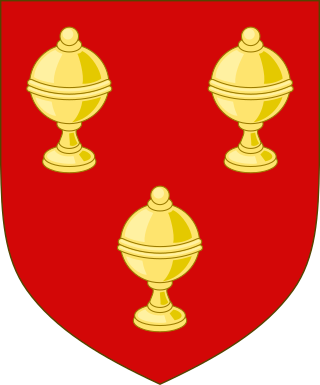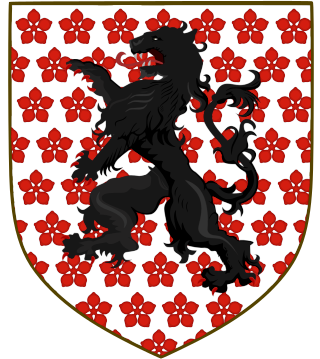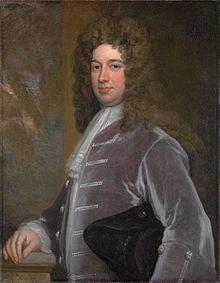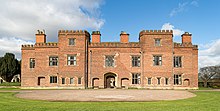Duke of Newcastle upon Tyne was a title that was created three times, once in the Peerage of England and twice in the Peerage of Great Britain. The first grant of the title was made in 1665 to William Cavendish, 1st Marquess of Newcastle upon Tyne. He was a prominent Royalist commander during the Civil War.
Duke of Buckingham held with Duke of Chandos, referring to Buckingham, is a title that has been created several times in the peerages of England, Great Britain, and the United Kingdom. There have also been earls and marquesses of Buckingham.

Duke of Somerset, from the county of Somerset, is a title that has been created five times in the peerage of England. It is particularly associated with two families: the Beauforts, who held the title from the creation of 1448, and the Seymours, from the creation of 1547, in whose name the title is still held. The present dukedom is unique, in that the first holder of the title created it for himself in his capacity of Lord Protector of the Kingdom of England, using a power granted in the will of his nephew King Edward VI.

Duke of Atholl, named for Atholl in Scotland, is a title in the Peerage of Scotland held by the head of Clan Murray. It was created by Queen Anne in 1703 for John Murray, 2nd Marquess of Atholl, with a special remainder to the heir male of his father, the 1st Marquess.

Evelyn Pierrepont, 1st Duke of Kingston-upon-Hull, was an English aristocrat, the third son of Robert Pierrepont of Thoresby, Nottinghamshire, and his wife Elizabeth Evelyn, and the grandson of William Pierrepont of Thoresby. He was born at West Dean, Wiltshire.

Earl of Portland is a title that has been created twice in the Peerage of England, firstly in 1633 and secondly in 1689. What proved to be a long co-held title, Duke of Portland, was created in 1716 and became extinct in 1990 upon the death of the ninth Duke, at which point the earldom passed to the most senior agnatic cousin, namely one of the 6th degree.

Earl Manvers was a title in the Peerage of the United Kingdom. It was created in 1806 for Charles Medows Pierrepont, 1st Viscount Newark. He had already been created Baron Pierrepont, of Holme Pierrepont in the County of Nottingham, and Viscount Newark, of Newark-on-Trent in the County of Nottingham, in 1796. Both these titles were in the Peerage of Great Britain. Born Charles Medows, he was the second son of Philip Medows, Deputy Ranger of Richmond Park, by Lady Frances Pierrepont, daughter of William Pierrepont, Earl of Kingston (1692–1713), eldest son and heir apparent of Evelyn Pierrepont, 1st Duke of Kingston-upon-Hull. The name of the earldom derives from the Manvers family, from a marriage to an heiress of which family the family seat of Holme Pierrepont had passed into the Pierrepont family in the 13th century.

Viscount Newark is a title that has been created twice in British history, each time with the subsidiary title of Baron Pierrepont.

The peerage title Earl of Ormond and the related titles Duke of Ormonde and Marquess of Ormonde have a long and complex history. An earldom of Ormond has been created three times in the Peerage of Ireland.
Pierrepont is the name or part of the name of several communes in France:

Robert Pierrepont, 1st Earl of Kingston-upon-Hull was an English nobleman who joined the Royalist side in the English Civil War after some delay and became lieutenant-general of the counties of Lincoln, Rutland, Huntingdon, Cambridge and Norfolk. He was killed in a friendly fire incident after being captured by Parliamentary forces.

Henry Pierrepont, 1st Marquess of Dorchester, PC, FRS, FRCP was an English peer. He was the son of Robert Pierrepont, 1st Earl of Kingston-upon-Hull, and his wife, the former Gertrude Talbot, daughter of George Talbot and Elizabeth Reyner, and cousin of the Earl of Shrewsbury.

William Pierrepont was an English politician who sat in the House of Commons at various times between 1640 and 1660. He supported the Parliamentary cause in the English Civil War.

Evelyn Pierrepont, 2nd Duke of Kingston-upon-Hull, KG was an English nobleman and landowner, a member of the House of Lords. He was the only son of William Pierrepont, Earl of Kingston-upon-Hull (1692–1713) and his wife, Rachel Bayntun (1695–1722).

Baron Pierrepont is a title that has been created four times in British history. The first creation came in the Peerage of England on 29 June 1627 when Sir Robert Pierrepont was created Baron Pierrepont, also being created Viscount Newark at the same time. He was further created Earl of Kingston-upon-Hull in 1628. The fifth Earl was created Duke of Kingston-upon-Hull in 1715 in the Peerage of Great Britain, with the Dukedom becoming extinct on the death of the second Duke in 1773.

Charles (Medows) Pierrepont, 1st Earl Manvers was a British naval officer and politician who sat in the House of Commons from 1778 to 1796 when he was raised to the peerage as Viscount Newark.

Holme Pierrepont Hall is a medieval Manor House in Holme Pierrepont near Nottingham. It is a Grade I listed building.

William Pierrepont, 4th Earl of Kingston-upon-Hull was a British peer and Member of Parliament.

Robert Pierrepont, 3rd Earl of Kingston-upon-Hull was an English peer.
Gertrude Pierrepont, Countess of Kingston-upon-Hull, born Gertrude Talbot, was an English noblewoman and peeress, the wife of Robert Pierrepont, 1st Earl of Kingston-upon-Hull, and the daughter of the Honourable Henry Talbot, and his wife, the former Elizabeth Reyner.

















